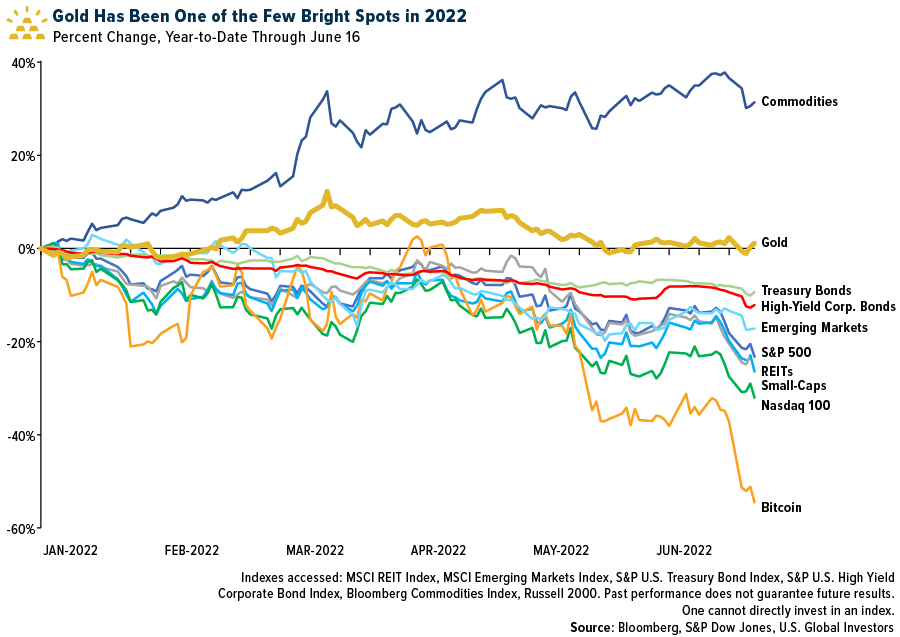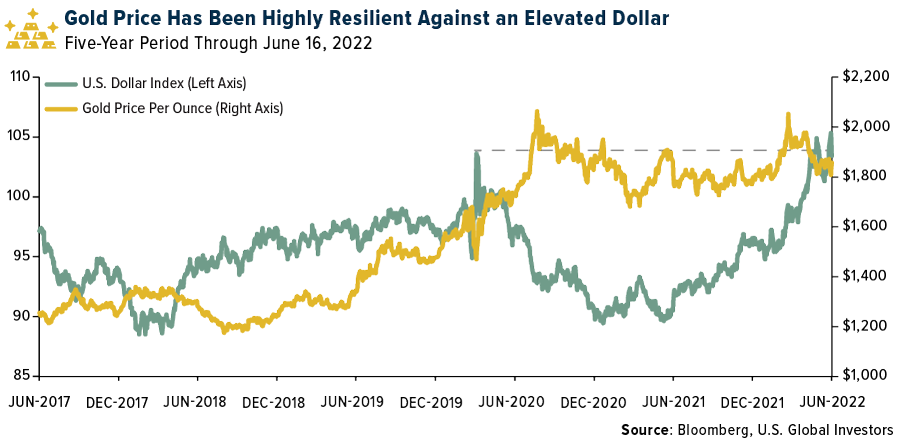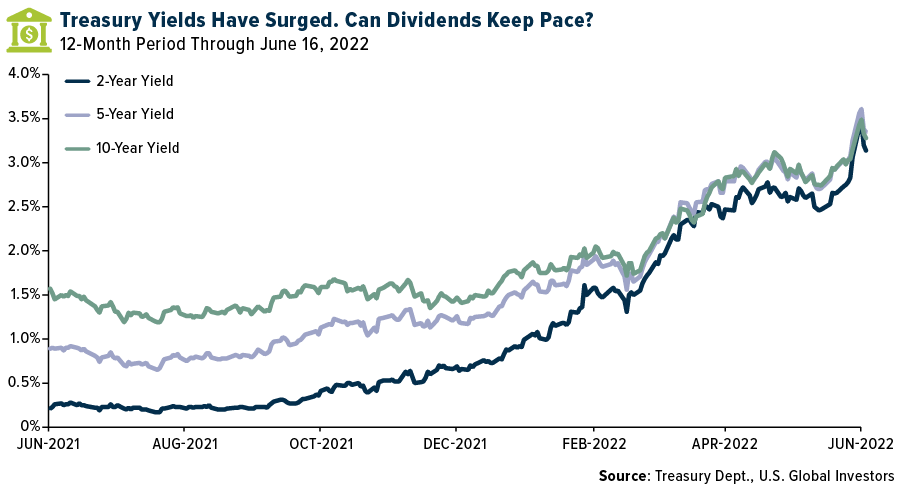We’re almost halfway through 2022, and so far gold has been the big winner after oil, coal and other commodities. The yellow metal has managed to stay positive since the start of the year, skirting pressure from surging yields and a strong U.S. dollar. Meanwhile, nearly every other asset class—from large-cap and small-cap equities to bonds, from real estate investment trusts (REITs) to cryptocurrencies—has fallen into either correction or bear market territory.

We believe this shows that gold has retained its perceived role as a store of value during times of decades-high inflation and economic and geopolitical uncertainty. As we like to say, investing in gold won’t make you a billionaire, but it could help stabilize your portfolio when the market is down.
Dollar at 20-Year Highs
We’re most impressed that gold has stayed afloat even as the U.S. dollar has strengthened to 20-year highs against a basket of other major currencies. Since gold is priced in dollars, the two assets have historically shared an inverse relationship, with one falling when the other rises, and vice versa. At the beginning of the pandemic, the dollar spiked as investors sought a safe haven, which put pressure on gold. The value of the dollar is now highly elevated on the back of interest rate hikes, and yet the yellow metal has continued to trade above $1,800 an ounce.
It’s for this reason, among others, that we agree with Newmont CEO Tom Palmer, who said last week that gold’s floor price has likely increased from previous support of around $1,200 to between $1,500 and $1,600 currently.

While we’re on this topic, a stronger dollar is mixed news. On the one hand, it can help limit the effects of inflation by offsetting the price of imports. On the other hand, it makes U.S. exports more expensive to overseas buyers. We’ll likely see lower fourth-quarter earnings for companies with international exposure as a result. Earlier this month, Microsoft joined Coca-Cola, Procter & Gamble and a host of other multinational U.S. companies in cutting forecasts for the remainder of the year due to a stronger greenback.
Will S&P 500 Companies Raise Their Dividends to Compete with Treasury Yields?
As we mentioned earlier, government bonds have steadily sold off this year, pushing yields to multiyear highs. (Bond yields rise when prices fall.) The two-year yield was trading as high as 3.45% last week, a substantial increase from 0.78% at the start of the year.

This may attract yield-seeking investors, but we urge them to keep in mind that inflation is running at an annual rate of 8.6%. That means they’re effectively paying the government for the privilege of holding its debt.
At the same time, dividend investors may have a hard time selecting stocks that pay out at a competitive rate. As of this month, the S&P 500 has a dividend yield of only 1.68%, up slightly from the beginning of 2022 but down from June 2020, when it was closer to 2.0%.
It’s well known that gold doesn’t pay any income, but with stocks and bonds out of favor, the metal may be a better bet to potentially keep ahead of inflation right now.
Get Access to Gold and Precious Metal Miners
Besides gold, we like explorers and producers that are involved in mining gold and other precious metals.
That’s especially true of royalty and streamlining companies, which we consider to be the “smart money” of the mining industry. Instead of actively mining metals themselves, these companies help finance the operations of other companies and, in exchange, receive either a cash royalty or a share of the produced material. Investors, then, can get exposure to precious metals without a lot of the risks that traditional mining companies must face.
Approximately 30% of our gold mining ETF, the U.S. Global GO GOLD and Precious Metal Miners ETF (GOAU),is comprised of the three leading royalty and streaming companies: Franco-Nevada, Royal Gold and Wheaton Precious Metals. The rest of the ETF is invested in well-managed, high-quality gold and precious metal producers with healthy balance sheets and a diversified portfolio of active mines.
Unlike some other precious metal ETFs, which are market cap-weighted, GOAU seeks to track the U.S. Global GO GOLD and Precious Metal Miners Index, a rules-based, smart-beta index that aims to invest in producers with positive free cash flow (FCF), momentum in revenue and high gross margins on a per-share basis.
GOAU is rebalanced and reconstituted every quarter for added benefit.
Explore GOAU today by clicking here!
*Smart-beta refers to a rules-based methodology that utilizes certain fundamental factors in its process.
All opinions expressed and data provided are subject to change without notice. Some of these opinions may not be appropriate to every investor.
Please carefully consider a fund’s investment objectives, risks, charges, and expenses. For this and other important information, obtain a statutory and summary prospectus for GOAU here. Read it carefully before investing.
Investing involves risk, including the possible loss of principal. Shares of any ETF are bought and sold at market price (not NAV), may trade at a discount or premium to NAV and are not individually redeemed from the funds. Brokerage commissions will reduce returns.
Because the funds concentrate their investments in specific industries, the funds may be subject to greater risks and fluctuations than a portfolio representing a broader range of industries. The funds are non-diversified, meaning they may concentrate more of their assets in a smaller number of issuers than diversified funds.
The funds invest in foreign securities which involve greater volatility and political, economic and currency risks and differences in accounting methods. These risks are greater for investments in emerging markets. The funds may invest in the securities of smaller-capitalization companies, which may be more volatile than funds that invest in larger, more established companies.
The performance of the funds may diverge from that of the index. Because the funds may employ a representative sampling strategy and may also invest in securities that are not included in the index, the funds may experience tracking error to a greater extent than funds that seek to replicate an index.
The funds are not actively managed and may be affected by a general decline in market segments related to the index. Gold, precious metals, and precious minerals funds may be susceptible to adverse economic, political, or regulatory developments due to concentrating in a single theme. The prices of gold, precious metals, and precious minerals are subject to substantial price fluctuations over short periods of time and may be affected by unpredicted international monetary and political policies. We suggest investing no more than 5% to 10% of your portfolio in these sectors.
Fund holdings and allocations are subject to change at any time. Click to view fund holdings for GOAU.
The company mentioned in this writeup that is not held by the GOAU ETF include: Newmont Mining.
Distributed by Quasar Distributors, LLC. U.S. Global Investors is the investment adviser to GOAU.
Smart beta refers to a type of exchange-traded fund (ETF) that uses a rules-based system for selecting investments to be included in the fund portfolio. Free cash flow (FCF) represents the cash a company generates after accounting for cash outflows to support operations and maintain its capital assets.
The S&P 500 is a stock market index tracking the stock performance of 500 large companies listed on exchanges in the United States. The Nasdaq-100 is a stock market index made up of 102 equity securities issued by 101 of the largest non-financial companies listed on the Nasdaq stock exchange. It is a modified capitalization-weighted index. The Russell 2000 Index is a U.S. equity index measuring the performance of the 2,000 smallest companies in the Russell 3000, a widely recognized small-cap index. The MSCI US REIT Index is a free float-adjusted market capitalization weighted index that is comprised of equity Real Estate Investment Trusts (REITs). The MSCI Emerging Markets Index is a selection of stocks that is designed to track the financial performance of key companies in fast-growing nations. The S&P U.S. Treasury Bond Index is a broad, comprehensive, market-value weighted index that seeks to measure the performance of the U.S. Treasury Bond market. The S&P U.S. High Yield Corporate Bond Index is designed to track the performance of U.S. dollar-denominated, high-yield corporate bonds issued by companies whose country of risk use official G-10 currencies, excluding those countries that are members of the United Nations Eastern European Group (EEG). The Bloomberg Commodity Index is a broadly diversified commodity price index distributed by Bloomberg Index Services Limited.
